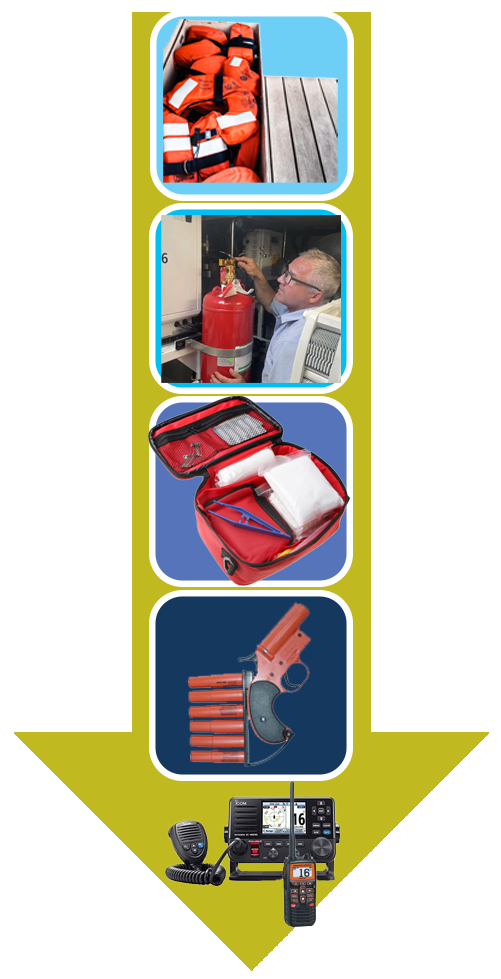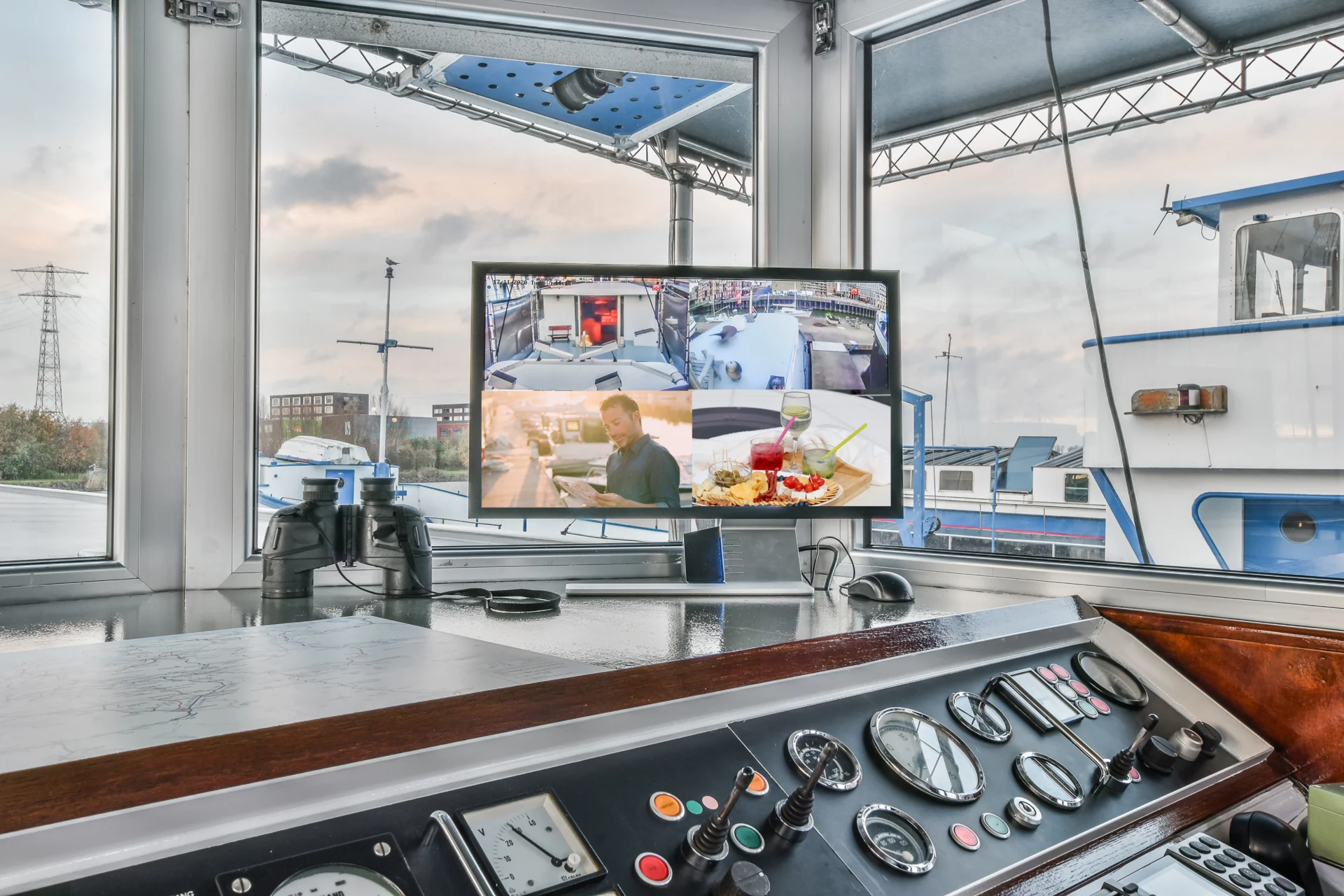Whether you’re planning a quick day trip or embarking on a long-distance voyage, safety should be at the forefront of your mind. Owning a yacht comes with the responsibility of ensuring all necessary precautions are in place for a secure experience on the water. At West Bay Shipyards, we’ve gathered some vital tips to help keep you, your crew, and your vessel safe at sea. This comprehensive guide will walk you through essential safety equipment, pre-voyage checks, and onboard practices that can make a critical difference in any situation.
Essential Safety Equipment
The first line of defense against any emergency at sea is having the proper equipment. A fully equipped safety kit meets maritime regulations and can prevent a minor problem from turning into a serious emergency. Make sure you have these things with you.
- Life Jackets: Life jackets are non-negotiable. Ensure each passenger has a properly fitted life jacket that’s easy to access and in good shape. An ill-fitting life jacket may not provide adequate safety. Consider upgrading to automatic inflating life jackets, which are more comfortable and reliable, especially in rough seas. Giving guests life jackets is just the first step, you must also demonstrate how to use them correctly. Even seasoned sailors benefit from reminders on properly fastening straps and adjusting them for snug, effective fit. Don’t underestimate this seemingly simple step, it could be the difference between life and death in unexpected situations.
- Fire Extinguishers: Because yachts have tight spaces and many flammable materials, fires tend to spread easily. Equip your vessel with fire extinguishers in critical areas such as the galley, engine room, and near electrical panels. You should regularly inspect the fire extinguishers to ensure they are fully charged and easily accessible during an emergency. Consider having multiple types of extinguishers for different types of fires (such as water-based for electrical fires). Knowing exactly where each extinguisher is located and having a fire plan makes all the difference if a fire breaks out.
- First Aid Kit: A well-stocked first aid kit allows you the ability to treat minor injuries and even provide critical care while waiting for professional medical assistance to arrive. Include bandages, antiseptic wipes, seasickness tablets, burn ointment, and a basic first aid manual. Consider additional supplies based on the size of your crew or any unique medical conditions. For longer trips, you may also want to have a small medical reference guide and even a “go-bag” with extra provisions in case an emergency requires you to abandon your vessel.
- Flares and Signaling Devices: In an emergency, getting attention quickly can be a lifesaver. Equip your yacht with a set of flares, an Emergency Position Indicating Radio Beacon (EPIRB), and other distress signals. These devices help rescuers locate you swiftly and accurately, even if you’re far from shore. Invest in solar-powered devices or waterproof options to ensure they function in wet, unpredictable conditions. Educating the crew on how to operate these devices, including where to find and activate them, will make a life-or-death difference in an emergency.
- Emergency Radio: Communication is critical during emergencies. Keep a VHF radio onboard, ideally one that’s waterproof and with a backup battery. Make sure it’s tested regularly and capable of reaching emergency services and nearby vessels. Having a radio won’t be useful if no one on board knows how to use it, so brief your crew on radio etiquette and practices. This includes knowing common distress channels and procedures to ensure swift and effective communication.

Pre-Voyage Safety Checks
Preparation is the best defense against an unexpected emergency. Before setting sail, take the time to perform thorough checks to ensure your equipment is in working order and that conditions are safe. Here’s what to keep in mind:
- Weather Forecast: Always check the weather forecast before departure. Look out for sudden weather changes, strong winds, or rough seas. If the forecast looks unfavorable, postpone your trip. Apps and websites may give real-time updates, but experienced sailors know to look for changing patterns in cloud cover, wind speeds, and sea swells as added indicators.
- Navigation Equipment: Ensure your navigation systems, GPS, and charts are fully functional. Have up-to-date charts for your planned route, and bring backups. Electronic failures happen, so it’s wise to have paper charts and a compass handy as well. Navigation is as much an art as it is a science; periodically practicing with your backup tools will give you confidence if digital tools fail.
- Engine and Fuel System: Inspect your engine and fuel system for leaks or mechanical issues. Routine checks on fuel levels, oil, and coolant will prevent unexpected breakdowns. Carry extra fuel for longer voyages, and make sure to monitor consumption rates. Small, portable toolkits onboard can help address minor issues as they arise. Having some basic spare parts, like fuel filters or belts, is also a wise precaution.
- Safety Drills: Familiarizing yourself with a variety of safety procedures can make a world of difference during emergencies. Conduct routine safety drills with your crew and passengers. Train everyone on the proper use of life jackets, flares, and how to handle emergency situations such as fire or man overboard. Assign roles to each crew member so everyone knows what to do when issues arise. Regular drills build muscle memory, allowing faster, calmer responses in actual situations.
Safety Practices Onboard
Once you’ve set sail, maintaining safe practices onboard is key to preventing accidents. Good habits avert emergencies and ensure everyone remains prepared to handle unforeseen situations.

- Regular Communication: Keeping others informed of your whereabouts, especially on extended voyages, is essential. Maintain regular contact with a shore-based friend or family member who tracks your journey and alerts authorities if communication fails. For additional peace of mind, consider a satellite tracker. Not only does it provide loved ones with real-time updates on your location, but it also allows you to send distress signals if needed.
- Stay Sober: Alcohol impairs judgment and reaction times, making it unsafe for anyone operating or navigating the yacht. Ensure the captain and crew remain sober and alert throughout the voyage. Encourage safe alternatives like mocktails or alcohol-free beverages that allow everyone to celebrate responsibly without compromising safety.
- Emergency Plan: Establish and review an emergency plan with your crew, ensuring that everyone knows their roles in a crisis. Cover essential procedures, including handling fires, medical emergencies, and the process for abandoning ship if necessary. Consider posting laminated instructions in common areas for easy access. Reviewing this plan regularly will keep procedures fresh in everyone’s minds.
- Secure Equipment: Loose equipment or clutter leads to accidents. Ensure that gear is stowed securely and the deck remains clear of obstructions. This prevents injuries and ensures essential equipment is accessible. Encourage the crew and passengers to tidy up after each activity, building a habit of safety that becomes second nature.
West Bay Shipyards’ Safety Solutions
At West Bay Shipyards, we go beyond the basics to ensure that your yacht is not only in top condition but also fully prepared for any emergency.
Safety Inspections
We offer thorough safety inspections for yachts of all sizes, ensuring that your vessel meets regulatory requirements and is equipped to handle emergencies. Our experts inspect everything from life jackets to fire extinguishers, making sure your safety measures are in place. In addition, we can help with minor repairs or adjustments to ensure your yacht’s safety setup is flawless
Maintenance and Upgrades
Safety equipment requires regular maintenance. We offer services to check and upgrade your safety systems, from replacing old flares to installing the latest navigation and communication equipment. Technology and safety equipment standards constantly evolve; our team stays updated on new products and improvements to ensure your yacht has the best possible protection.
Prioritizing yacht safety is crucial for a smooth, enjoyable voyage. By investing in the right equipment and preparing thoroughly, you can reduce risks and handle emergencies effectively. At West Bay Shipyards, we are committed to helping yacht owners like you ensure that safety comes first. Whether you need a comprehensive safety inspection, emergency training, or maintenance services, we’re here to support your secure adventures on the water. With the right preparation, every journey on your yacht can be safe, enjoyable, and worry-free.
I could not refrain from commenting. Perfectly written.